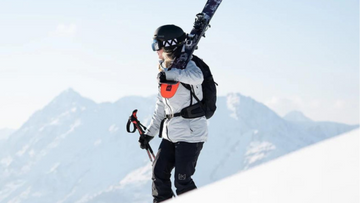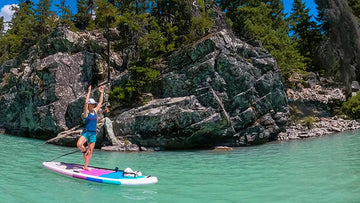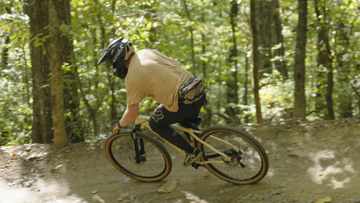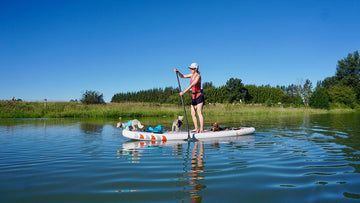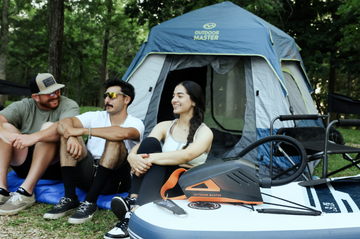
If you're thinking of buying a paddle board, there are some things you need to know before making your purchase.
In this article, we'll discuss the different types of paddle boards available, as well as the pros and cons of each. We'll also provide tips on how to choose the right paddle board for your needs, and give you an overview of the prices you can expect to pay.
Similar to TVs, this article has some advertisements that I recommend you to know about. Outdoor Master offers reliable paddle boards at affordable prices that you can take advantage of during deal days or when free shipping is available site-wide.
I recommend you to go check them out now to grab something you like or to just know about their products and wait till you can get them with a great deal.
Now that you know that, let's start with the first thing you should know before buying your paddle board.
Table of content
What To Expect In Terms Of Budget Inflatable Vs Solid Board What Board Type Do You Need Get The Right Board Size The Hull Shape To Choose Paddle Board Weight Paddle Board Volume Sup Paddle Correct Length The Importance Of Sup Fins Accessories To Have With You FAQsWhat To Expect In Terms Of Budget
There is a wide range of prices when it comes to paddle boards. The most expensive models can cost upwards of $1,500, while the more budget-friendly options may be as low as $300. In general, you can expect to pay anywhere from $400 to $700 for a decent paddle board.
Of course, the price you ultimately pay will depend on a number of factors, including the type of the board, the brand, the quality of the materials used, and any features or accessories that are included.
If you're looking for a top-of-the-line recreational paddle board, you can expect to pay closer to $900. However, if you're willing to sacrifice a bit of quality in exchange for a lower price, you can find paddle boards for as little as $350.
Inflatable Vs Solid Board
The first thing you need to decide is whether you want an inflatable or a solid board.
Inflatable boards are easier to transport, and store, better suited to handle bumps up against rocks and logs, and softer for fitness moves on the water. Solid boards offer better performance on the water and feel more stable on the water, but they are difficult to transport and store.
Ultimately, the decision comes down to personal preference.
If you're looking for a board that's easy to transport and store, go with an inflatable. If you're after the best performance possible, go with a solid paddle board.
Related reading: Inflatable VS Solid Paddle Board: What Are The Differences?
What Board Type Do You Need
There are a few different types of paddle boards to choose from, and each has its own set of pros and cons. In this section, we'll take a closer look at each type:
TOURING PADDLE BOARDS
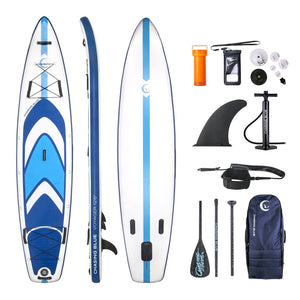
ORION iSUP BOARD
12'6" With Double Layer Material
Shop NowUSE CODE: OMBLOG20 for 10% OFF
Touring paddle boards are designed for long-distance paddling and are typically between 12 and 14 feet in length. They range between 30" to 32" in width. However, they're also heavier and more difficult to maneuver.
RACING PADDLE BOARDS
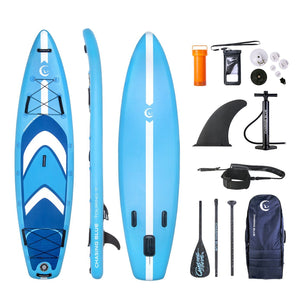
ACE iSUP BOARD
11' With Double Layer Material
Shop NowUSE CODE: OMBLOG20 for 10% OFF
Racing paddle boards are designed for speed and agility. They're usually between 12 and 14 feet long, but they can be as short as 10 feet. They're also much narrower than any type of paddle boards, typically ranging from 25" to 30" in width. This makes them faster, but less stable.
FITNESS PADDLE BOARDS
These paddle boards are designed specifically for fitness. They're usually between 10 and 12 feet long and 33" to 38" wide for added stability. They often have nonslip surfaces and tie-down points for fitness mats and other fitness accessories.
SURFING PADDLE BOARDS
Surfing paddle boards are shorter than most other types of paddle boards, usually around 9 to 10 feet in length. They're also narrower, typically ranging from 30" to 31" in width. This makes them easier to maneuver on waves.
FISHING PADDLE BOARDS
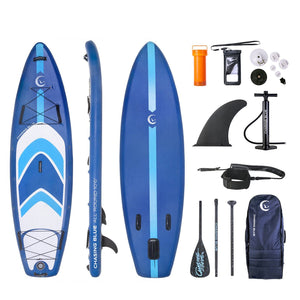
INFINITE iSUP BOARD
10'6" With Double Layer Material
Shop NowUSE CODE: OMBLOG20 for 10% OFF
Fishing paddle boards are designed to provide a stable platform for fishing. They're usually between 12 and 14 feet long, with a width of around 36". They often have features like fishing mounts.
Related reading:
Fishing Paddle Board | How to Choose Your Best Fishing iSUP?
Paddle Board Fishing | Everything You Need to Know
Paddle board VS Kayak: Speed, Fishing, Which is Easy to Flip, and More
YOGA PADDLE BOARDS

SYNERGY ISUP BOARD
10'6" With Double Layer Material
Shop NowUSE CODE: OMBLOG20 for 10% OFF
SUP yoga is a special type of yoga that’s getting more and more popular over these years. Yoga paddle board are designed to provide a maximum stability on any water body. You can count on your giant yoga paddle board to help you stay on the water surface for the most of the time.
Related reading: Everything You Need to Know About SUP Yoga
ALL-AROUND PADDLE BOARDS
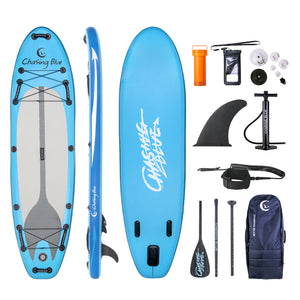
OCEAN SPIRIT iSUP BOARD
10'6" FOR ALL-LEVEL
Shop NowUSE CODE: OMBLOG20 for 10% OFF
All-around paddle boards are just that: they're designed to be versatile and can be used for a variety of activities. They're usually between 10 and 12 feet long, and can be as short as 8 feet. They range from 28" to 34" in width.
Now that you know a little more about the different types of paddle boards available, let's take a look at some of the things you should consider when choosing the right one for you.
Get The Right Board Size
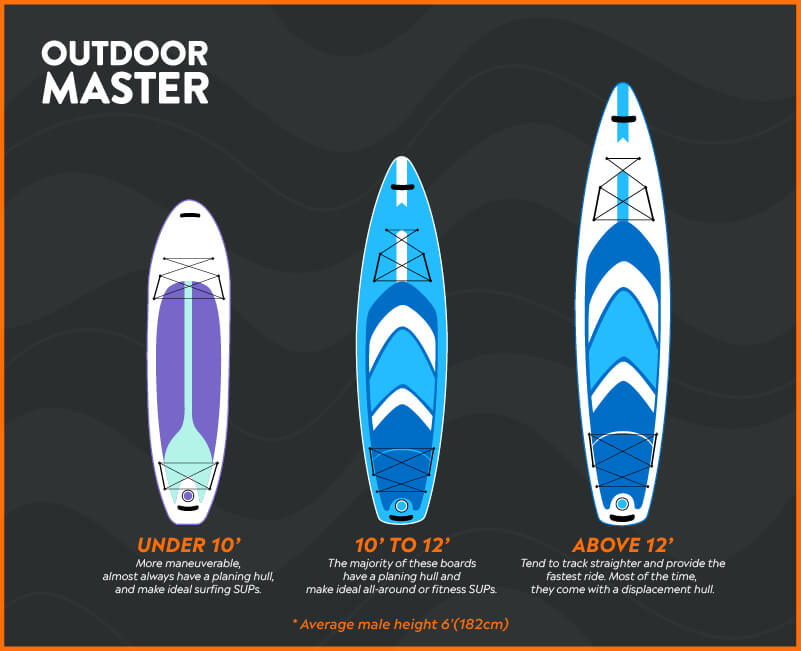
One of the most important things to consider when purchasing a paddle board is size. Paddle boards come in a variety of sizes and it is important to choose the right one for your individual needs.
The first thing to consider is what type of paddling you will be doing.
If you are planning on doing mostly flat water paddling, such as on lakes or calm rivers, then you will want to choose a larger board. These boards are great for stability and provide a great deal of space to move around.
If you are planning on doing more whitewater paddling or surfing, then you will want to choose a smaller board. These boards are easier to maneuver in the water and will give you a better surfboard-like experience.
The next thing to consider is your own personal size and weight. If you are a larger person or if you plan on carrying a lot of gear with you, then you will want to choose a larger board. If you are smaller or if you want a board that is more maneuverable, then you will want to choose a smaller board.
Once you have considered these factors, you can then begin to look at paddle boards and compare their sizes. Most paddle boards will have their dimensions listed in length, width, and thickness. It is important to pay attention to all three of these dimensions when choosing a board. The length of the board will determine how fast it is in the water (longer boards are faster), the width will determine how stable it is, and the thickness will determine how much flotation it has.
The Hull Shape To Choose
The hull comes in a variety of shapes. The two most common hull shapes are the displacement hull and the planing hull.

Displacement hulls have a V-shape front that slice through the water and provide good tracking (the ability to go in a straight line) but they are less maneuverable. These hulls are often found on racing and touring paddle boards.
Planing hulls have a wide and flat bottom that ride on top of the water. These hulls are often found on all-around and fitness paddle boards and are stable and great for maneuverability.
Paddle Board Weight
The weight of the paddle board is important to consider for a few different reasons.
First, you need to be able to carry your board to and from the water. If the board is too heavy, this can be difficult.
Second, the weight of the board will affect how it rides on the water. Heavier boards will sit lower in the water and may be more stable, but they will also be slower. Lighter boards will sit higher on the water and will be faster, but they may be less stable.
For me, any paddle board under 20 lbs I consider it a lightweight one that is easy for adults to carry.
Paddle Board Volume
The volume of the paddle board is the amount of space inside the board and is measured in liters. The volume of the board will affect how stable it feels and how much weight it can hold.
If you are a larger person or if you plan on carrying a lot of gear with you, then you will want to choose a board with a higher volume. If you are smaller or if you want a board that is more maneuverable, then you can choose a board with a lower volume.
Paddlers under 200lbs can float well on any adults paddle board, unlike other paddlers up to 240lbs, who have to look for paddle boards at least 180L to feel stable on the water.
If you are over 280lbs, you should have a paddle board with at least 240L of volume.
To avoid riding too slow in the water or feeling super unstable, you should get the right size for you, not too small and not too big.
Just note, if we give the same board to different brands, they may give it two different weight capacities, and this is normal unless the industry got standards. So, take those numbers with a little salt to avoid disappointment.
SUP Paddle Correct Length
The length of your paddle should be based on your height and what you are doing with your SUP board.
To get the right paddle length for recreational touring, stand next to your paddle with the handle in your hand and extend your arm over your head. The paddle handle should rest in the bend of your wrist.
If you are going to be SUP surfing, you want to get a paddle that’s a bit shorter. Unless for SUP racing, it should be a bit longer than recreational touring SUP paddles.
The Importance Of SUP Fins

SUP fins provide stability and also help with tracking.
When buying your paddle board, you should consider its size and shape. Fins that are large and have a large base provides more stability compared to smaller fins which are known to provide higher maneuverability.
Paddle boards with a larger center fin and smaller side ones provide more maneuverability while others with a single fin track well and makes the board faster because they have minimal drag.
Accessories To Have With You
Besides the paddle, bag, fins, leash, and the hand pump that most paddle board packages include, there are other SUP accessories that you should know about.
ELECTRIC PUMP
Inflating your paddle board with a hand pump can be more frustrating than you may expect, especially if you are not fit or on a smaller side.
Electric SUP pumps make inflating your paddle board a lot easier and faster. The best electric pumps have a cooling system that let them inflate multiple boards before having to stop to cool down.
Related reading: WHY I RECOMMEND SUP ELECTRIC PUMP?
PFD/LIFE JACKET
It is recommended to wear a PFD (personal flotation device) or a life jacket when paddle boarding.
There are several different types of PFDs and life jackets available, from inflatable belts to vests, but the most important thing is that you choose one that is comfortable and does not restrict your movements.
Related reading: How do you do a SUP rescue? | Paddle to Safety
DRY BAG
A dry bag is a must-have if you are planning on doing any SUPing in open water, such as touring or fishing.
Dry bags come in a variety of sizes and shapes, so choose one that is big enough to fit all your gear but not too big or bulky that it becomes a hassle to carry.
WATER BOTTLE
It is important to stay hydrated when paddle boarding, especially on hot days. A water bottle with a clip or holder is a great way to keep your hands free and stay hydrated at the same time.
SUNGLASSES/HAT
The water reflects the sun so you will need some type of eye protection.
A hat is also essential to protect your face and head from the sun.
Related reading: 9 Best Polarized Sunglasses of 2022 | Expert Review
WHISTLE
Carry a whistle with you in case you need to signal for help. The best ones are loud and have an attachment that makes them hard to lose.
WARRANTY/GUARANTEE
Warranties and guarantees are important to consider when buying a paddle board.
Most paddle boards come with a one to two years warranty, but there are some that have longer warranties. Some companies also offer money-back guarantees if you are not satisfied with the board or you received it with manufacturer defects.
It is important to read the warranty and guarantee policies before purchasing a paddle board to make sure you are covered in case something goes wrong.
FAQs
IS BUYING A PADDLE BOARD WORTH IT?
Yes, buying a paddle board is worth it if you will be using it often and for years.
For the average person, a paddle board will last around 3 years with proper care. With that being said, it is still important to do your research before purchasing a paddle board to ensure you are getting the best value for your money.
DO INFLATABLE PADDLE BOARDS PUNCTURE EASILY?
Inflatable paddle boards are often thought to be less durable than traditional hard boards, but this is not always the case. Some inflatable boards are made with high-quality materials and can withstand quite a bit of wear and tear. However, if you are concerned about durability, it is always a good idea to read reviews before making a purchase.
IS IT EASY TO FALL OFF A PADDLEBOARD?
While paddle boarding is not as inherently dangerous as, say, whitewater rafting, it is still important to be aware of the risks involved in the activity. One of the most common dangers when paddle boarding is falling off the board. This can happen for a number of reasons, such as losing balance, being hit by a wave, or simply capsizing.
Fortunately, falling off a paddle board is not usually very dangerous. If you know how to fall off the board, the main risk is that you may get wet and cold, which can be uncomfortable or even dangerous if you are not dressed appropriately. It is also important to be aware of any obstacles in the water that could cause you to fall off your board. For example, rocks or reefs can be a major hazard if you are not paying attention.
CAN YOU PADDLE BOARD IN THE RAIN?
Paddle boarding in the rain is not recommended. The main reason for this is that paddle boards are very slippery when wet. This can make it very difficult to keep your balance, and you may fall off more easily. In addition, rain can make the water choppier, which can make it harder to paddle.
If you do decide to paddle board in the rain, be sure to dress appropriately. Wear a wet suit or other waterproof clothing so that you will not get too cold if you fall into the water. Also, be sure to bring a life jacket just in case.
Now that you know what to look for when buying a paddle board, you can begin your search for the perfect board for you. There are a variety of brands and models on the market, so take your time and find the one that best suits your needs.
If something is unclear for you or you need further help, you can still join our SUP-dedicated Facebook group to get help from our staff and the other members or to just meet with like-minded people.
Thank you for your time.
See y'all.


